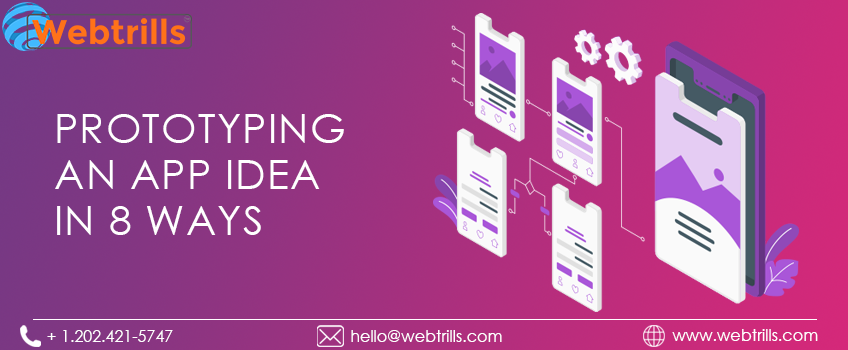
How to Prototype an App Idea in 8 ways
As a developer, we must understand every application before actually developing it, what is it about, what someone is expecting out of it, how many screens it should contain and how future users are going to interact with it. To get all this done, we at obfu.com, one of the leading mobile application development countries across the world, thoroughly examine the idea of our customer’s and then set on to develop a prototype for the future app.
For mobile software development, prototype refers to an interactive but not functional draft of an actual application. The prototype of a potential application shows the UI design, including the user flow and the planned functionality. Prototyping is referred to as modelling the UI design of an app without real coding. It is a part of the pre-development process, generally performed as an integral part of the planning stage before the actual development of an application. It is a rough draft, generally made by the project manager without the involvement of the design team.
The prototype of an application might also be beneficial for any start-up, as before pitching about your app to mobile app investors, you will have a real idea of what your app will look like. This will differentiate you from other start-ups and make you stand out with a solid base.
This is how prototyping for any potential application is done:
1. Communicating with the customers: Understanding the purpose of an app should always be prioritized as it forms the basis on what all features and specifications the app must actually contain without bogging down with loads of details. The developers must concentrate on the concept and leave all the details that will be formulated in the ongoing process.
2. Looking for similar apps: After the idea, insight and concept are captured, the next step would be to draft the potential mobile app. In order to check how good, the idea is, mobile market analysis is performed to understand the current market demand of this particular app, the availability of competitive services that are addressing the exact needs, their advantages and flaws. Before developing something new, one must look out for stuff that is already present in the market as it will give an idea about whether the app will be used or not, whether it can compete with its rivals and whether it will return your investments and make profits. It will also provide knowledge on the best time to enter the market.
After the idea is proven to be technologically feasible and financially promising, a green light is given to create a prototype for a mobile app. This is the next step towards the development of a prototype that involves formulating all the data that must be included in the app. This data includes a list of required features, technical specifications, sketches or drafts of desired UI and structure of the app. User flows is worked out for each of the significant features, the sequence of actions that must be performed by the users to reach their goal.
3. Wireframing the structure of the potential app: Wireframes refers to the barebone structure of the app with all the predicted user routes and links but without any design elements. Wireframes are created on paper or in any graphic editor software’s using classic pen and paper sketching or directly employing specialized digital tools.
4. Building a static prototype: In this step, a static prototype is developed; it might be as a result of the wireframing step or is performed additionally in parallel with the wireframing step. The primary objective of this step is to set and show the alterations between different app pages; A rough mock-up is performed for each screen. Generally, Figma is used, but other software’s such as Sketch, Balsamiq, Adobe Illustrator also works fine. Then screens are organized into flows by adding arrows and comments such as “click button A to open screen B”.
5. Adding error screens: Our thinking generally works in alternative scenarios when the users fail to achieve their objectives. In such scenarios, the app must inform the users that the operation has failed or an error has occurred. All these cases are also added to our wireframes.
6. Crash test: This refers to the discussion that is carried out by the entire team, including experts and volunteering enthusiasts, in order to discuss the flows, the team have come up with. If anything is not user-friendly, it is generally discarded, and further brainstorming is done to come up with new ideas on how to improve the user experience. The results of this step are used to amend all the detected flaws. This entire process is repeated again and again until the team is left with a highly interactive prototype and bulletproof user scenario.
7. Product demo: Screens are combined into a prototype that is clickable or constituting arrows and is further demonstrated to the consumer. After the demo, customers are never satisfied with everything; they would either want to change one thing or another. Customer’s feedback is always very crucial while prototyping, as it ensures intuitive and convenient operations with making the mobile applications highly appealing for the target audience. If everything doesn’t work fine, still there is nothing to worry about everything will be managed. We are not a company claiming to read the minds of our customers but are claiming to hold their hands along the way to obtain their goals.
8. Fine-tuning: All the adjustments that are requested by our customers throughout the way are finally adjusted, and another final demo is made. Finally, when everyone is happy with the demo and adjustments, the designers or the developers are handed over the finalized user flows to prepare estimates.
Further recommendations on the prototypes, we at obfu.com don’t use colours for our prototypes. During the analysis phase, we generally go with neutral backgrounds to concentrate on the functionalities of the application without getting distracted by the bold colours of the buttons. We also do prefer clickable prototypes as clickable ones help the team to identify any missing screens and will also help the customers understand the working of the app better and also to generate more and better feedback.
- Tags: Marketing, Onlline, Internet





